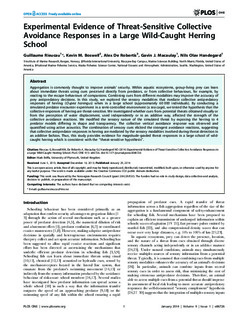| dc.contributor.author | Rieucau, Guillaume | |
| dc.contributor.author | Boswell, Kevin M. | |
| dc.contributor.author | De Robertis, Alex | |
| dc.contributor.author | Macaulay, Gavin J. | |
| dc.contributor.author | Handegard, Nils Olav | |
| dc.date.accessioned | 2014-02-03T09:38:12Z | |
| dc.date.available | 2014-02-03T09:38:12Z | |
| dc.date.issued | 2014-01-29 | |
| dc.identifier.citation | Rieucau G, Boswell KM, De Robertis A, Macaulay GJ, Handegard NO (2014) Experimental Evidence of Threat-Sensitive Collective Avoidance Responses in a Large Wild-Caught Herring School. PLoS ONE 9(1): e86726. | no_NO |
| dc.identifier.issn | 1932-6203 | |
| dc.identifier.uri | http://hdl.handle.net/11250/109323 | |
| dc.description.abstract | Aggregation is commonly thought to improve animals' security. Within aquatic ecosystems, group-living prey can learn about immediate threats using cues perceived directly from predators, or from collective behaviours, for example, by reacting to the escape behaviours of companions. Combining cues from different modalities may improve the accuracy of prey antipredatory decisions. In this study, we explored the sensory modalities that mediate collective antipredatory responses of herring (Clupea harengus) when in a large school (approximately 60 000 individuals). By conducting a simulated predator encounter experiment in a semi-controlled environment (a sea cage), we tested the hypothesis that the collective responses of herring are threat-sensitive. We investigated whether cues from potential threats obtained visually or from the perception of water displacement, used independently or in an additive way, affected the strength of the collective avoidance reactions. We modified the sensory nature of the simulated threat by exposing the herring to 4 predator models differing in shape and transparency. The collective vertical avoidance response was observed and quantified using active acoustics. The combination of sensory cues elicited the strongest avoidance reactions, suggesting that collective antipredator responses in herring are mediated by the sensory modalities involved during threat detection in an additive fashion. Thus, this study provides evidence for magnitude-graded threat responses in a large school of wild-caught herring which is consistent with the “threat-sensitive hypothesis”. | no_NO |
| dc.language.iso | eng | no_NO |
| dc.publisher | Public Library of Science | no_NO |
| dc.title | Experimental Evidence of Threat-Sensitive Collective Avoidance Responses in a Large Wild-Caught Herring School | no_NO |
| dc.type | Journal article | no_NO |
| dc.type | Peer reviewed | no_NO |
| dc.subject.nsi | VDP::Agriculture and fishery disciplines: 900::Fisheries science: 920::Fish health: 923 | no_NO |
| dc.source.pagenumber | 9 p. | no_NO |
| dc.source.volume | 9 | no_NO |
| dc.source.journal | PLoS ONE | no_NO |
| dc.source.issue | 1 | no_NO |
| dc.identifier.doi | 10.1371/journal.pone.0086726 | |
| dc.relation.project | Norwegian Research Council: 204229/F20 | no_NO |
